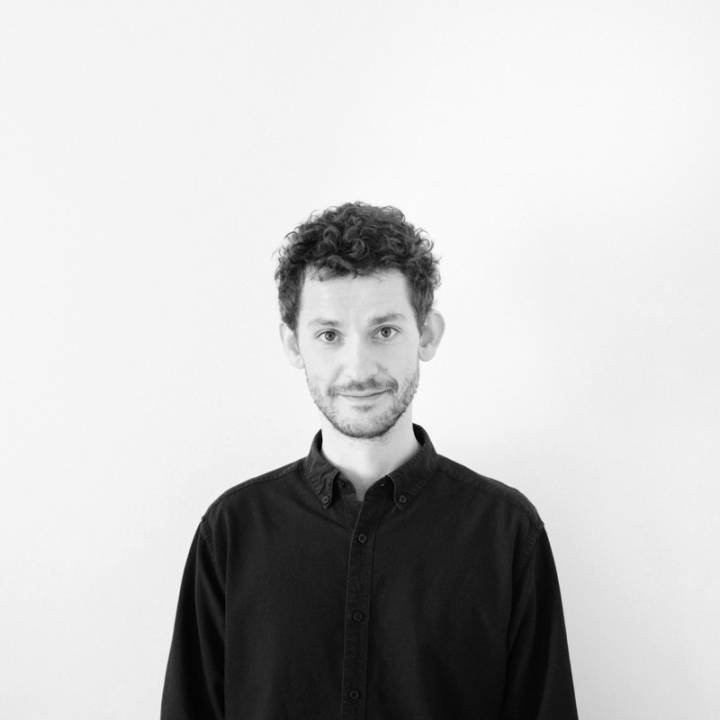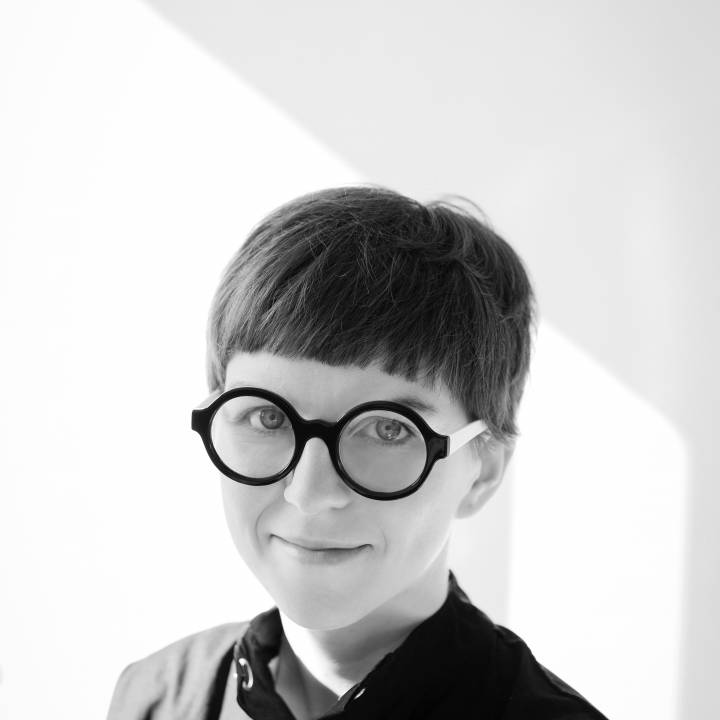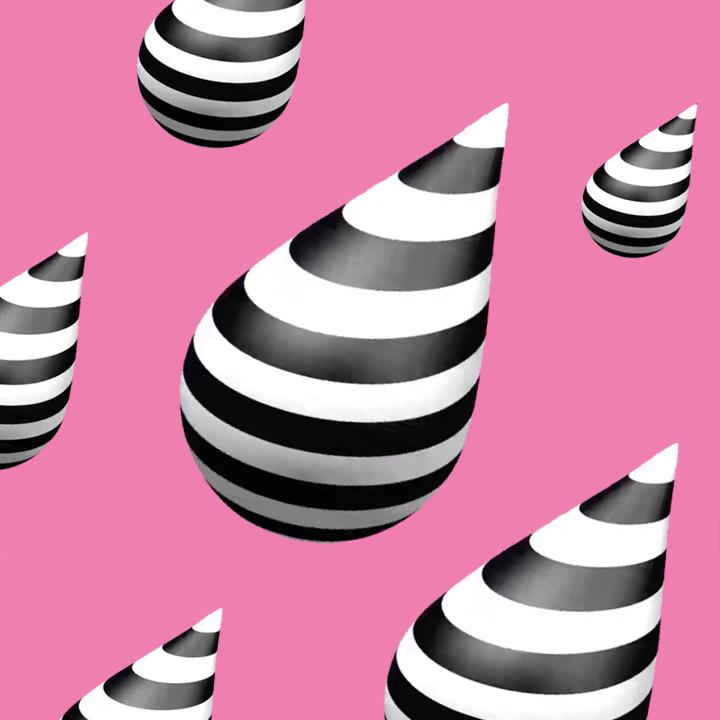

Water is our problem
Poland is looking for effective methods for water management. We can learn this from countries which have already faced this situation or took appropriate measures on time to avoid problems.
According to data, we currently have the lowest water resources in the European Union. It is connected with climate changes, which result in increasing drought. It is not all though. As a result of many years of negligence, we also have problem to stop rainwater which flows off to the Baltic Sea too fast. We have also been systematically increasing consumption of underground waters for some time now, even though their resources renew very slowly. Poland has a problem with water and if we do nothing, shortly not only prices of food will increase but also prices of many products and services and our economy will be highly affected.
We can learn how to handle the water crisis from countries which have already faced similar situation or took appropriate measures on time to avoid problems. There are many sources of inspiration – at present, half of a humankind suffers from shortage of drinking water, and according to scientists 20 more countries will face shortages of this life-giving resource by 2020.
We may carry out water desalination, extract it from fog, recycle it or implement extensive municipal rationalization programmes, same as in Cape Town which have been struggling with droughts for years. These are just some solutions that you may see during the exhibition “Water is Our Problem”. Curators of the exhibition, Michał Bachowski and Agata Nowak, decided to show projects from all around the world which present the methods of saving, obtaining, treatment and supplying water, and which can be successfully implemented in other places as well.
Harvesting
Water covers 71% of the world's surface. Why is it so difficult to obtain it?
97% of water resources is seawater, which cannot be consumed by people nor used in agriculture without expensive and power-consuming desalination process. Above 2/3 of the remaining 3%, which in theory can be used, is frozen in ice caps and glaciers. It turns out then that life-giving sweet water, which can be quite easily obtained from rivers, lakes, swamps, wetlands, and the underground surfaces is less than 1% of all water resources.
These resources are renewed by rain and snow but the process is slow whilst people rapidly increase consumption. Additionally, not everybody has the same access to water. Poland has one of the smallest water resources in the whole European Union. Only 1,400 m3 in our country constitute the so-called renewable resources of sweat water per citizen, the average value of this factor for the whole community is almost 3,000 m3 and for the world, it is 5,900 m3. The reason for such a situation is drought and the fact that we retain too little rainwater which quickly flows to the Baltic sea. Currently, we only retain 6.5. % of water which flows through Poland. According to experts, it is by half too little at least.
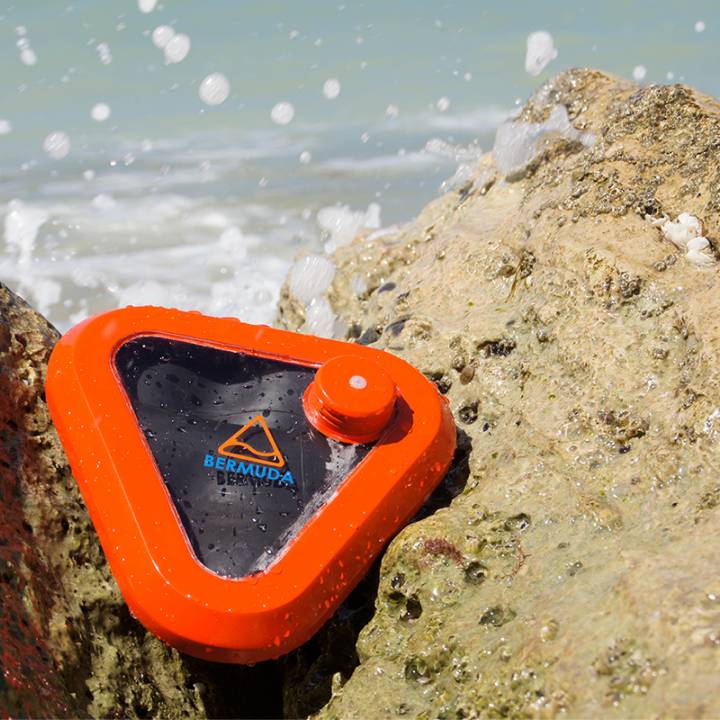
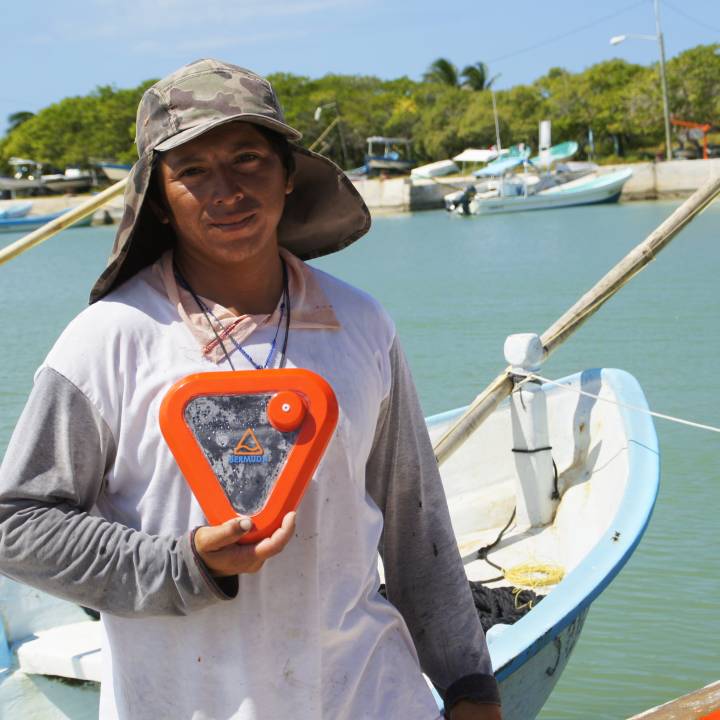
Bermuda
product
Economic, personal water desalination device designed for emergency situations.
97% of the liquid in the world is salt water, which cannot be used for drinking or in agriculture, unless it is desalinated. In the past, potable water was harvested this way mainly on vessels or in dry but reach regions such as Saudi Arabia or Israel (large scale desalination remains very expensive). Due to the water crisis and desalination technology development based on reverse osmosis, the process started to grow in popularity also, amongst others, in Spain, the USA or China. Mexican designer, Marco Antonio Barba Sánchez noticed however that there are no such solutions on the market intended for individual users. His small-size water desalination device was developed for emergency situations where there is nothing to drink but sea water and sun light are easily accessible (e.g. on fish boats). The device utilises solar distillation to separate the water from the salt. Liquid obtained from the process undergoes filtration to remove bacteria, algae and deposits. Both processes are carried out in a blown reservoir. Air pressure between its outside and inside part can be manually controlled generating vacuum to reduce the boiling point of the sea water. It also allows to control vapour saturation pressure in the next stage of the process, thus condensation is faster. The designer assesses that Bermuda may generate from 2.1 up to 4.2 litres of potable water daily, depending on the sunlight.
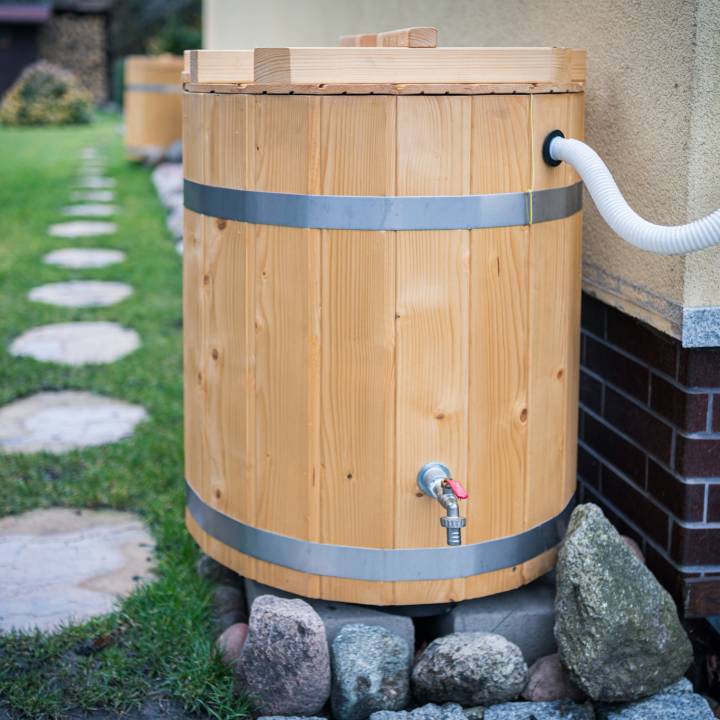
Programme “Catch the Rain”
urban project
2019
First Polish city programme co-funding household installations collecting rainwater.
Currently, only 6.5% of water which flows through Poland is retained. According to experts, it is too little by at least a half. We can change this by trying to store more rainwater which can be utilized for example to water lawns. However, this is not only a way to save tap water which is often of a very good quality, but also to lower flood risk. The rains in recent years have become more torrential, therefore rainwater is not absorbed into the soil and flows into rivers or overloads inspection chambers in the cities. Thus, in 2019, the city hall of Wrocław implemented a pilotage version of the programme Catch the Rain. The citizens could receive even PLN 5,000 funding to the installation collecting rainwater in households. The city co-funded the construction of rain gardens, soakaways and underground and gutter storage reservoirs. The interest of citizens in the undertaking was so high that in 2020 the city launched another edition with doubled budget.
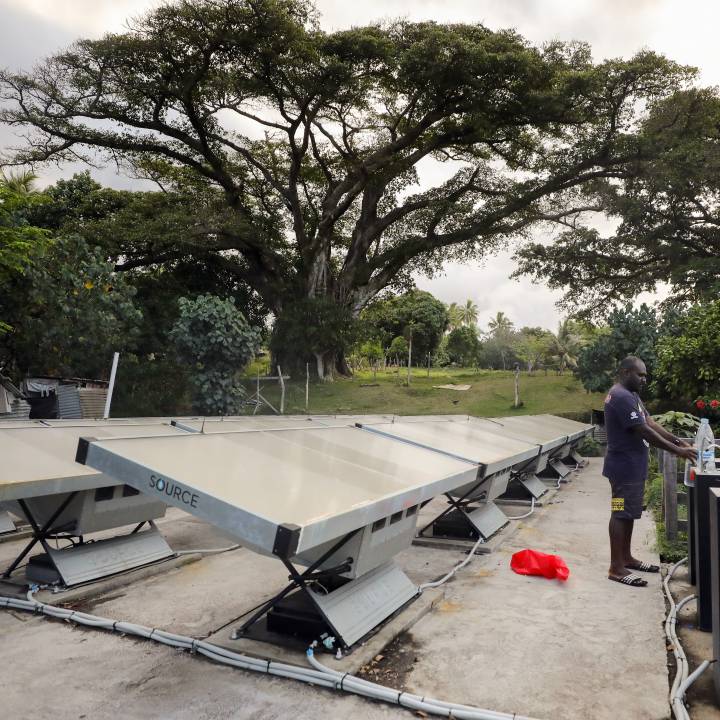
Rexi Hydropanel
hydropanel
Hydropanels powered with solar energy, which generate water out of air.
The air always partly consists of water vapour, which content largely depends of temperature. Therefore, in regions with water shortage, there are more trials to obtain this live-giving resource from air. One of the most marketed devices of this kind was presented during the famous technological fairs CES 2020 in Las Vegas. Modular Rexi hydropanels manufactured by the Zero Mass Water company resemble standard photovoltaic panels and can also be installed on the roofs of private houses. They do not require electric energy or any public utilities infrastructure so are proven as fitting any place in the world. To generate potable water, they only need the air and the sunlight.
How does a hydropanel function? The photovoltaic installation supplies power to the ventilator which sucks in large quantities of air to the device in which it is heated. Next, air is cooled down to the ambient temperature and condensing water particles settle on a hygroscopic material. Finally, the water is collected in a special reservoir, in which it is ozonized and mineralized to remove the specific taste and to obtain appropriate pH value. The price of one Rexi hydropanel, size 1m x 1.5m, is $ 2,500.
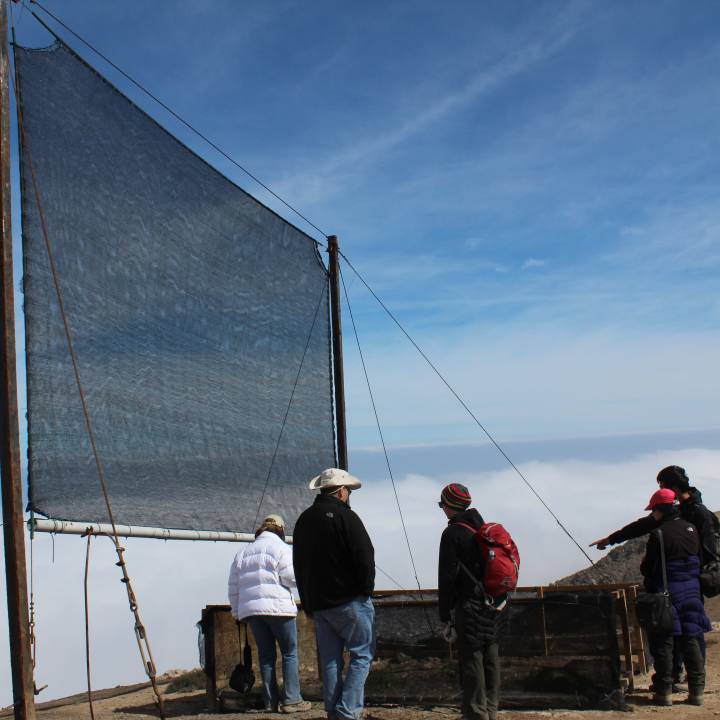
Fog Catcher
installation
Installations which allow for water extraction from fog in the regions of Peru with low precipitation level.
Lima is a city surrounded by a desert, in which precipitation during the 12-month period is only at the level of 16 mm/m2 (to compare – the average annual precipitation in Gdynia is 563 mm/m2). As a result, more than 1.3 mln of inhabitants of the Peruvian capital have no access to running water. At the same time, humidity in this region can be surprisingly high. In winter, when a thick fog from the Pacific ocean covers the area, the air humidity in Lima reaches even 98%, even though there is no precipitation. That is why, an alternative way of obtaining water was implemented. The Peruvians Without Water organization began to build installations, the so called Fog catchers, in the poor suburbs of Lima, which make it possible to condensate fog. It is a system of nylon nets which resemble sails and catch small particles of liquid from air draining it to special barrels. Each of them can generate between 300 and 400 litres of water per day, which can be used not only for sanitary purposes, but also to water plants or for drinking. The Dutch Creating Water Foundation helped to design these installations. The organisation also created simple manuals thanks to which members of local community can learn how to build and repair 60 nets themselves, utilized by almost 500 families.
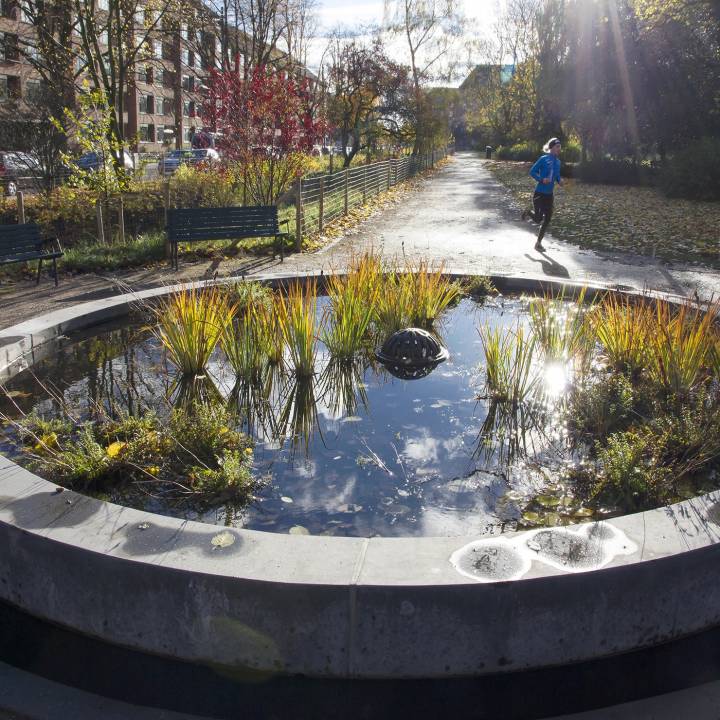
Danish methods for small scale water retention in the cities
small architecture
Instead of sealing the cities, Danish people focus on water retention on every possible surface.
There has been a specific trend in Polish cities for years to cut down trees and to replace green areas with car parks, squares of concrete slabs, compact housing developments, etc. The most visible effect of this phenomenon, known as betonoza (Polish slang term for large areas of concrete), is the overheating of such areas during summer periods. That is not all, though. Water from precipitation, which has become less frequent but more torrential during recent years, often has no possibility to be absorbed by the ground, thus causing local flooding. To cope with this problem, we should invest in a small scale water retention system. This is what Danes have been doing for years trying to retain water in cities on every possible surface. The process is supported by, amongst others, such designing solutions and examples of small architecture as soakaways which are installed on lawns, unsealed curbs, waterholes which retain rainwater, or green roofs.
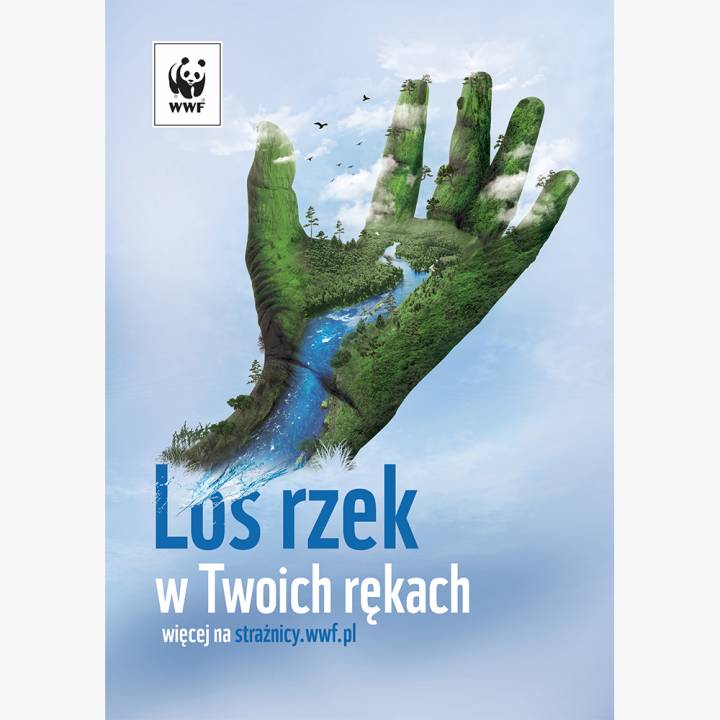
WWF Poland, the rivers guards
social action
The programme for saving Polish rivers against damaging changes due to which they cannot fulfill their ecosystem functions.
Maintenance works destroy rivers and organisms which live in them. That is not all though. Regulating, straightening, building embankments, digging through, and cementing riverbeds lead to drying out of the area, and degradation of habitats. It is a real threat during times in which we face longer droughts periods. Only naturally flowing rivers together with their habitats ensure good water storage, which means that rivers store water when there is an excess of it and slowly release it to the environment when there is water deficit. Unfortunately, the scale of irresponsible policy is huge in this regard. Each year, due to, amongst others, maintenance works, 20 thousand km of Polish rivers are destroyed, thus only about 20% of rivers remained in their original condition. That is why, in 2018, WWF Poland Foundation implemented the Rivers Guards WWF programme, to which representatives of local communities are engaged. Their main tasks are to observe rivers and prevent damaging changes due to which rivers cannot fulfill their ecosystem functions. The programme is focused in particular on supporting the protection of small rivers where the threat is largest. One of the partners of the undertaking is the Swiss brand Geberit, which specializes in providing sanitary technologies. The company promotes action and works on increasing the awareness of people about the problem among people. The company created the character of Gabi, which speaks in social media about rivers, and their ecosystem, tells how to save water in households and encourages to join the Rivers Guards.
Purification
According to UN, even 2.1 mld people in the world have no access to proper quality water at home.
The World Health organization accesses that diseases transmitted by water are the cause of about 1.8 mln deaths annually, of which 88% results from no access to safe drinking water, sanitary condition, and hygiene. Additionally, ecologists from the MARE foundation are alarming that above 12 mln tones of plastic waste reaches seas and oceans each year. It is estimated that if we do not change our habits, by 2050 there will be more waste in the seas and oceans than fish, which already mistake microplastic with food. As far as the situation in Poland is concerned, the company Wody Polskie informed at the beginning of May 2020 that the problem with contamination of rivers and reservoirs has been recently growing. It is nothing new. Measurements made 4 years earlier showed that water quality was good in only 178 sections of tested rivers, and it was bad in as much as 1452 sections. The cause lies in repeated failures of waste treatment plants, which are difficult to maintain by many communes. The problem is also waste and impurities thrown by people directly to rivers and water reservoirs.
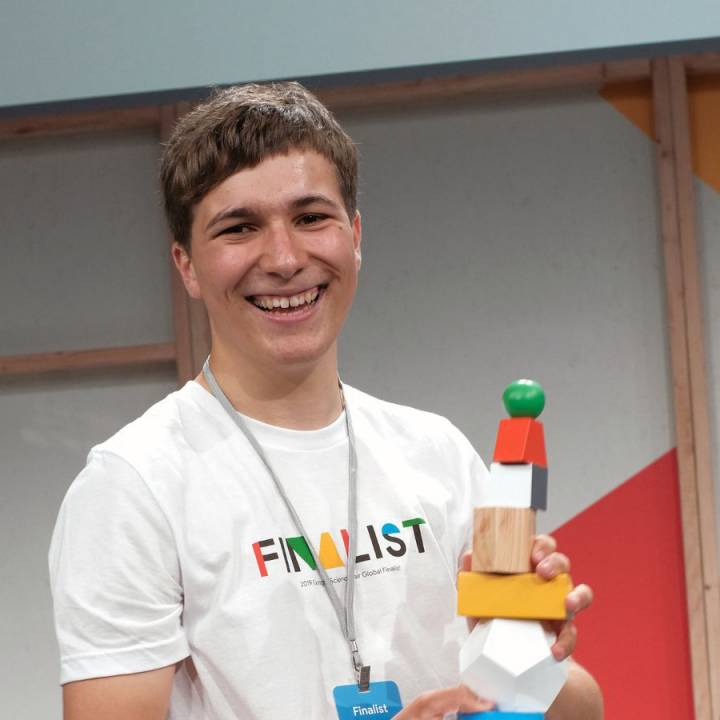
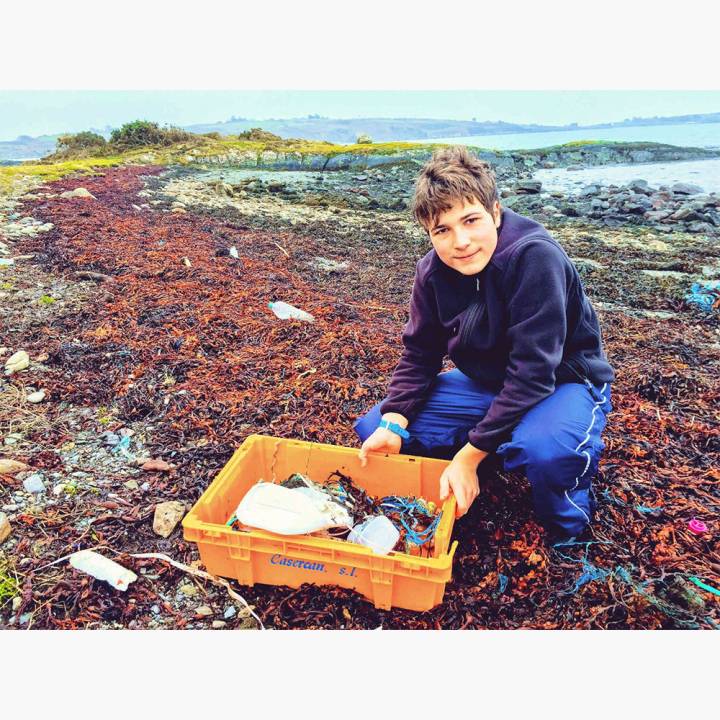
Microplastic Extraction from Water
study project
The project of microplastic removal from water, for which the Irish teenager, Fionn Ferreira, was awarded the Google Science Fair.
Studies show that an average person consumes up to even 70,000 particles of plastic annually with diameter less than 5 mm, which may generate toxic chemical substances. How is it possible? Microplastic can be found, amongst others, in fish which we eat as they mistake waste with food. That is why, it is so important to look for methods of water purification. Fionn Ferreirs saw it himself, winning $ 50 thousand in the prestigious Google Science Fair competition for students aged 13 to 18. This young Irishman proposed a new method for microplastic removal from water using ferrofluid. It is a compound of a harmless magnetic fluid which draws small particles of plastic thanks to high magnetic polarization. Ferreira carried out about 1000 trials and was able to remove even 87 % of impurities from water. Currently, the young scientist works on using his method on a mass scale.
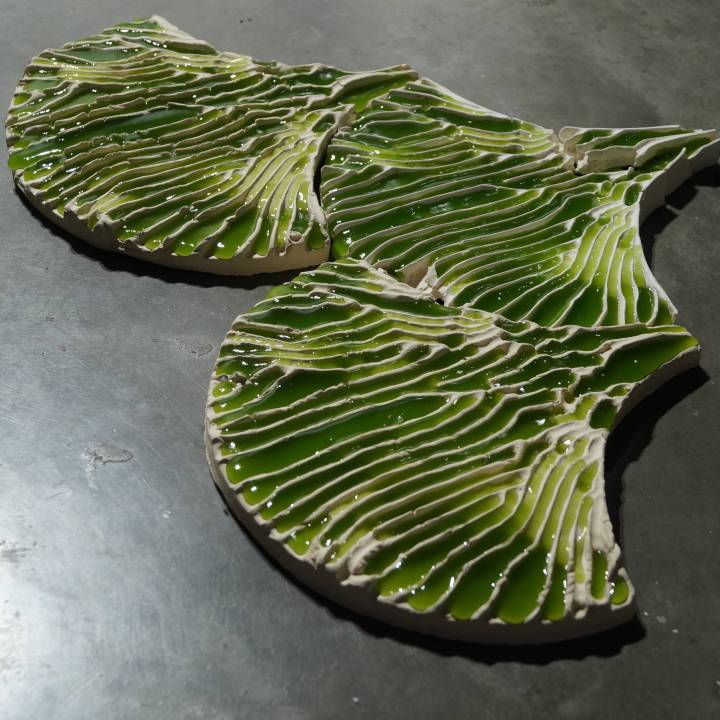
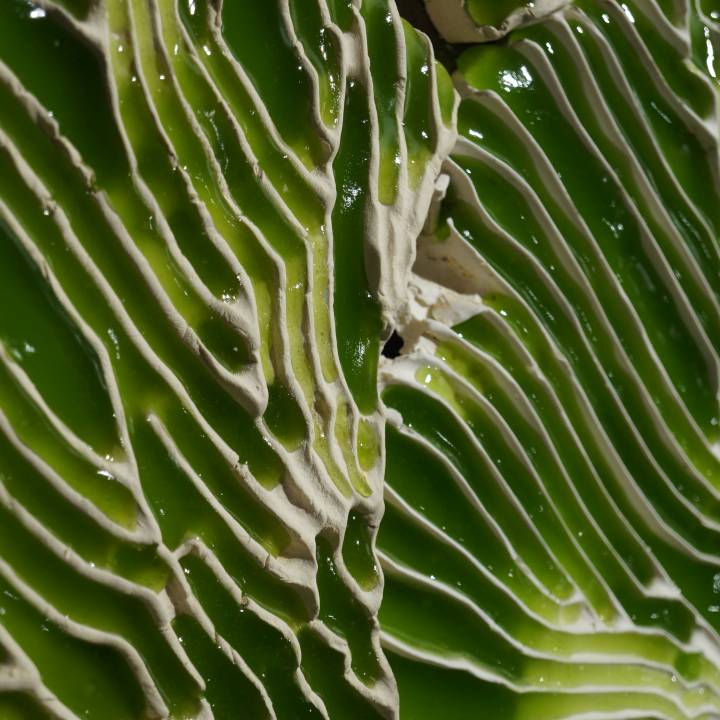
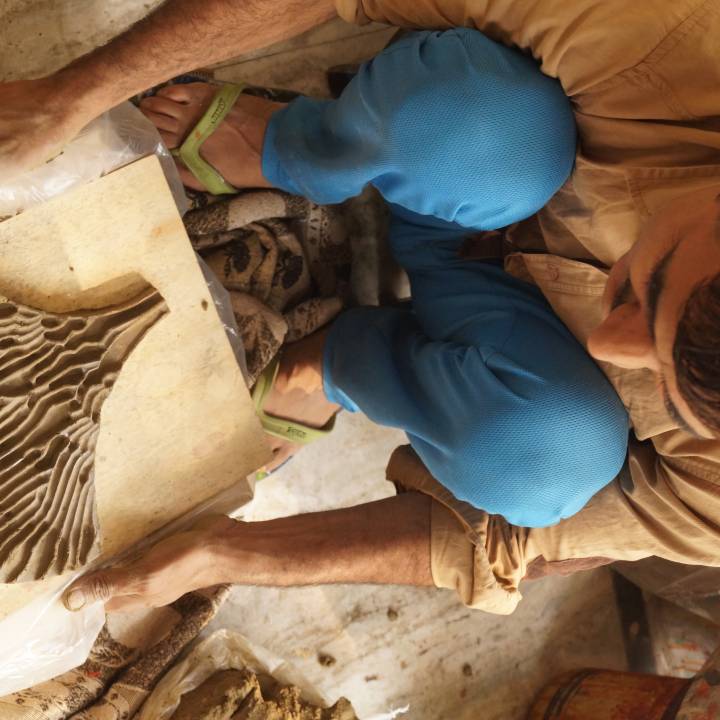
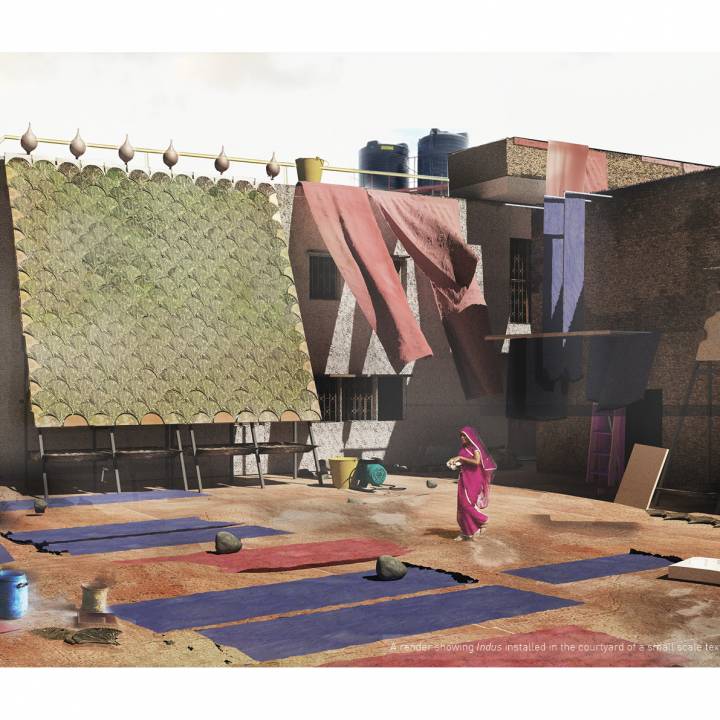
Indus
filtrating panels
Panels covered with algae which can filter water in rivers contaminated with chemical agents and heavy metals.
A significant reason of inland waters contamination are, amongst others, chemical fertilisers from industrial plants, and cleaning agents and pharmaceuticals we use that destroy bio-diversity of rivers and natural reservoirs. Their removal is complex and time consuming, but it turns out that, e.g., algae can be used for this purpose. Algae are species which can filter toxic chemical agents and heavy metals out of the water, and scientists from Bio-Integrated Design Lab at the Bartlett School of Architecture have developed a method to use them. The scientists have developed a modular system of clay tiles Indus inlaid with a network of channels which resemble the structure of leaves. It facilitates filling their surface with micro-algae using biodegradable hydrogel, which keeps algae alive. Panels structure inspired by nature allows for even distribution of water, which improves filtration. Depending on the river or lake contamination level, the durability of a single module can vary from few weeks to few months. Fortunately, their replacement is easy, thus operational costs of the system are much lower.
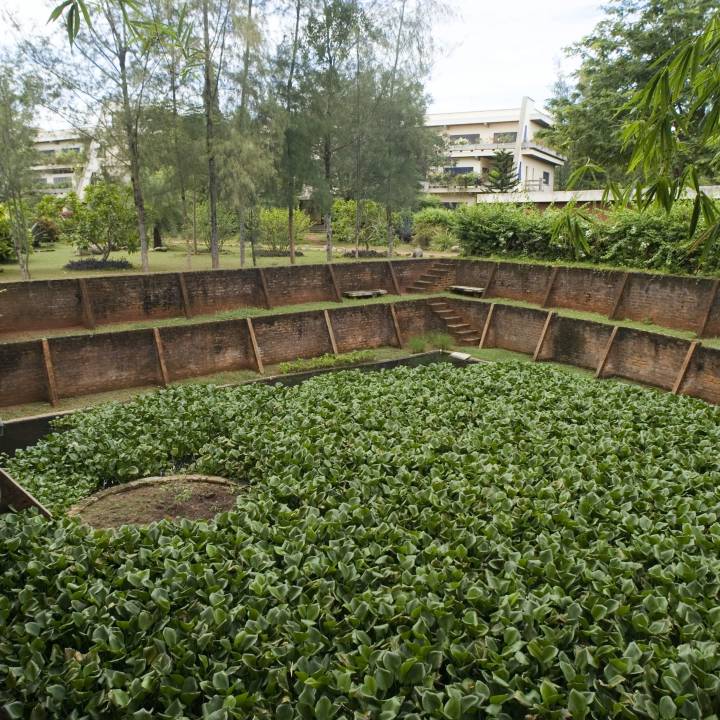
Sewage treatment using plants
project
Treatment plants, which not only remove contaminants from water but also rebuilt natural swamp areas.
Swamps and wetlands can effectively retain rainwater. Thanks to its various locations and local character, they are much more effective than artificial retention reservoirs. They can be compared to a sponge, which absorbs water when it rains and stores it during drought. Additionally, they also absorb CO2. Unfortunately, according to dr Łukasz Kozuba from SGGW (Warsaw University of Life Sciences), Poland has lost about 80% of natural swamps and wetlands as they were reclaimed for years for the needs of agriculture. If we do not start to restore them soon, we will have a very serious problem.
One of the ways to change the current situation is by constructing treatment plants that use plants and rebuilt natural swamp areas. They use natural processes to remove contaminants from water which occur in wet areas. Plants that usually grow in swamps, such as typha or sweet flag, are planted in such areas. Microorganisms grow in the roots of such plants and cause biodegradation of sewage. They can deal with various types of waste and their construction and maintenance cost are lower than in the case of traditional treatment plants (they require double space though). They are also small retention objects and decrease the effects of drought.

Water Canary
product
A simple sensor which detects water contamination without tests.
Contact with contaminated water can be the cause of serious diseases and complications. To avoid it and to start improving the situation, we need to realize the problem.
In Poland water supplied in water pipelines is regularly and thoroughly tested. Unfortunately, water from private intakes, e.g. from wells, is not subject to any restrictions, even though it should be tested several times a year. It was difficult for years as in order to test the water in the field, trained experts were needed as well as expensive equipment and more or less 24 hours for chemical reactions to show results.
Water Canary can be a solution to this problem. It is a sensor which easily shows if the water is contaminated. To test the water, it is enough to put a sample to the device and after few seconds the light will switch on: red one means that the water is contaminated, and green one means that the water is safe. Water Canary aims at making it possible for everyone to collect information that rescue lives and monitor changing water quality. The device can be used everywhere, but it was mainly created keeping in mind those countries in which contaminated water can spread such diseases as e.g. cholera.
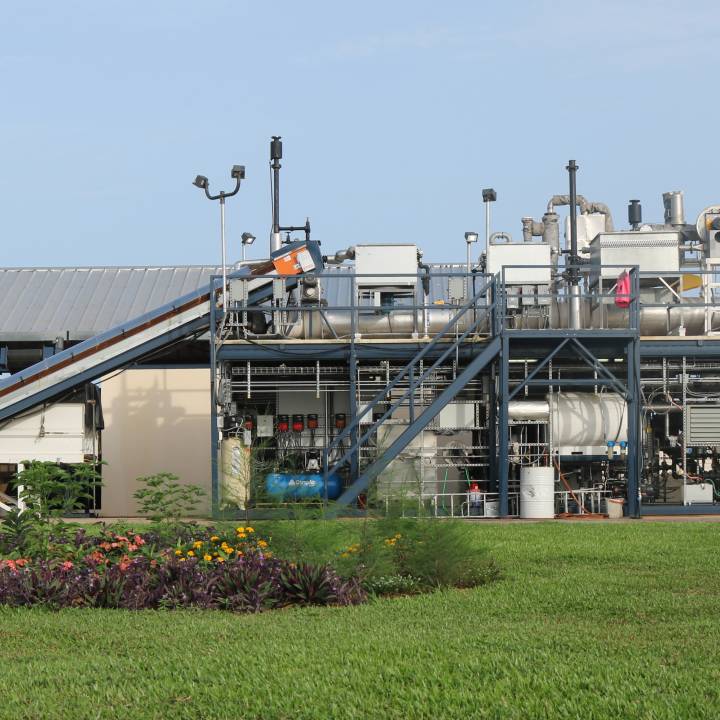
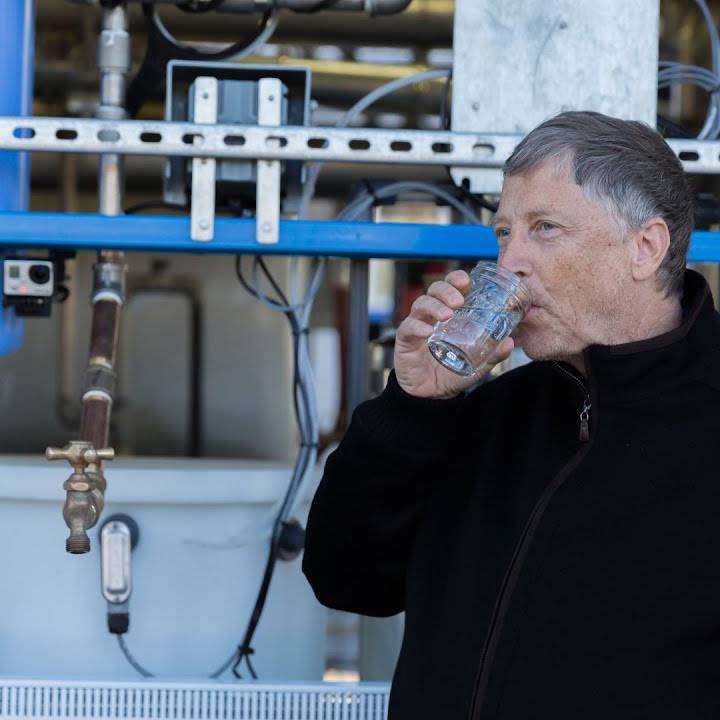
Omni Processor
device
Devices which recover potable water from sewage treatment processes. Their manufacture is funded by the Foundation of Bill and Melinda Gates.
Increasing draughts, together with the increase of the underground waters consumption, may cause that Poles will be forced to recover water, including potable water, from alternative sources. The solution may be sewage recycling, a method which is used in countries that had no other options, e.g. in Africa. A few years ago, The Foundation of Bill and Melinda Gates started to fund the development of this kind of technology, namely Omni Processors which are manufactured by the company Sedron Technologies. The devices operate based on the reverse osmosis phenomenon. First, sewage is heated generating water vapour, which is then separated from impurities and undergoes condensation. Remaining sewage deposits are dried and turned into biomass, which is combusted to provide additional power supply to the generator. The whole process generates water, which, after the removal of bacteria and other pathogens from it, can be used as potable water and electric energy. Omni Processor recovers 800 g of water and 200 g of biomass from 1000 g of waste. Costs of one installation is between USD 2 – 4 millions. The test device was installed in Dakar, Senegal.
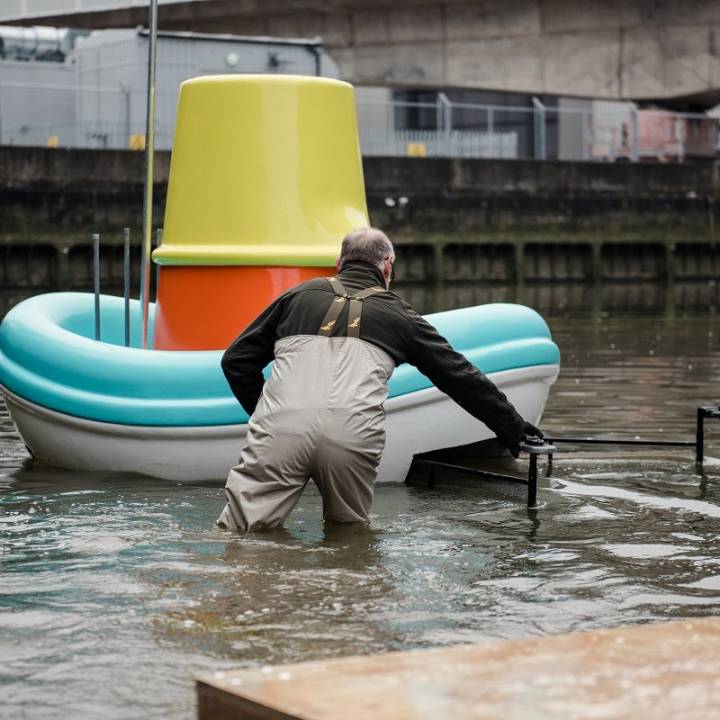
The Good Ship IKEA
boat
A remotely controlled boat in the shape of an IKEA toy, which is used to clear rivers of waste.
At the beginning of May 2020, the Wody Polskie company took notice of the increasing problem with contamination of our rivers and reservoirs. The problem is the result of, amongst others, waste being still thrown to water or to the areas nearby waters by the citizens of our country. For example, 1.5 tons of waste is collected only at the 1 km section of the waterside in Wrocław during the spring-summer season. Clearing of Polish rivers and reservoirs could be supported by remotely controlled boats, similar to those that not long ago were seen on one of the channels that flow into Thames. They were created as a part of the The Good Ship IKEA campaign, which was to promote the opening of a chain store in London, thus, there was a striking resemblance to a popular toy of this brand. However, this does not mean the boats were only used for advertisement purposes. Each of them was able to collect 20 kg of waste at once. The boats were also used to educate local community about waste sorting and environment cleaning. With the completion of the campaign, they were donated to the ecological organization Hubbub.
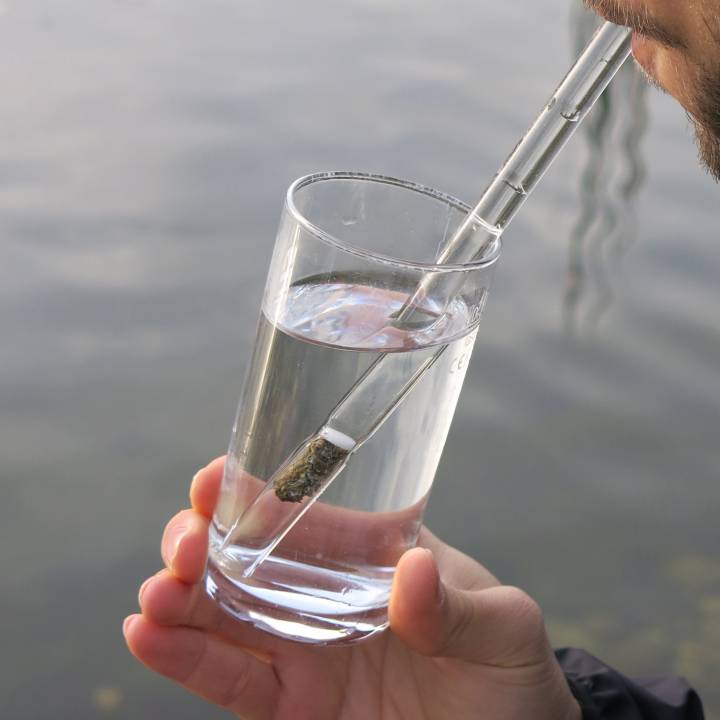
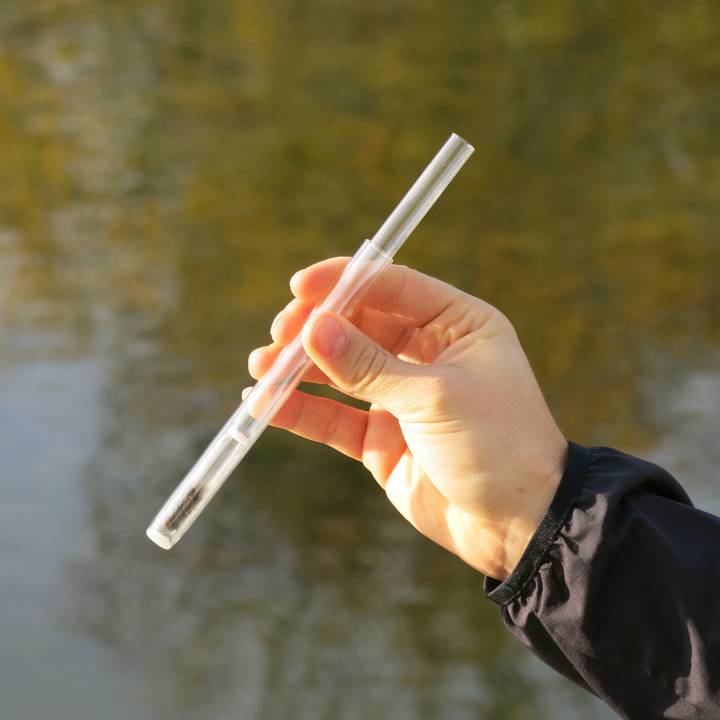
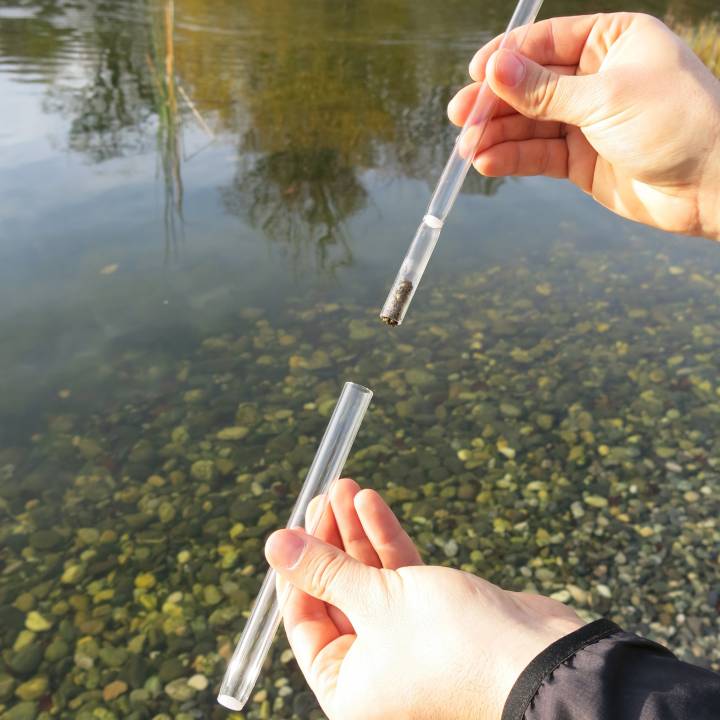
Filtering Glass Straw
straw
A glass straw with a natural water filter, which may be an alternative to plastic filters.
Many Poles are still afraid to drink water straight from the tap. This fear is most often ungrounded as our water is usually of a very good quality. However, this is why plastic bottles with filters are so popular in our country. The problem is that they get worn out quickly increasing pollution, whilst they are only needed in emergency situations. That is why, a good alternative may be the Filtering Glass Straw, which was created having in mind such situations in particular. It is a straw made of glass tubes with a natural filtrating insert between them made of dry cilantro and powder of active coal and moringa seeds. All ingredients are known of its purifying properties. The insert is kept in place by two discs made of fritted glass which porosity is well-balanced to obtain an effective filtration.
Saving
There are more and more calls worldwide underlying the necessity to save water, which is understandable.
It is estimated that currently ¼ of the population faces a water crisis and by 2040 citizens of the next 20 countries will be facing it. Only some of them live in naturally dry areas. In many places, such a situation is connected with the increase of population, urbanization, environmental pollution, effects of climate changes such as droughts, and wasting water. Poland is amongst the group in which water consumption has increased by 6 times in recent 35 years, even though our resources are the smallest one in the region. According to data prepared by the Central Statistical Office, as much as 72% of water consumption in our country is for industrial purposes, mainly coal energetics and mining. Next on the list is water and sewage system, which supplies water to, amongst others, households and is responsible for 18 % of water consumption. The remaining 10% of water is consumed by agriculture, which is in the first position in many other regions of the world. It is worth remembering this distribution considering the areas in which we can save water.
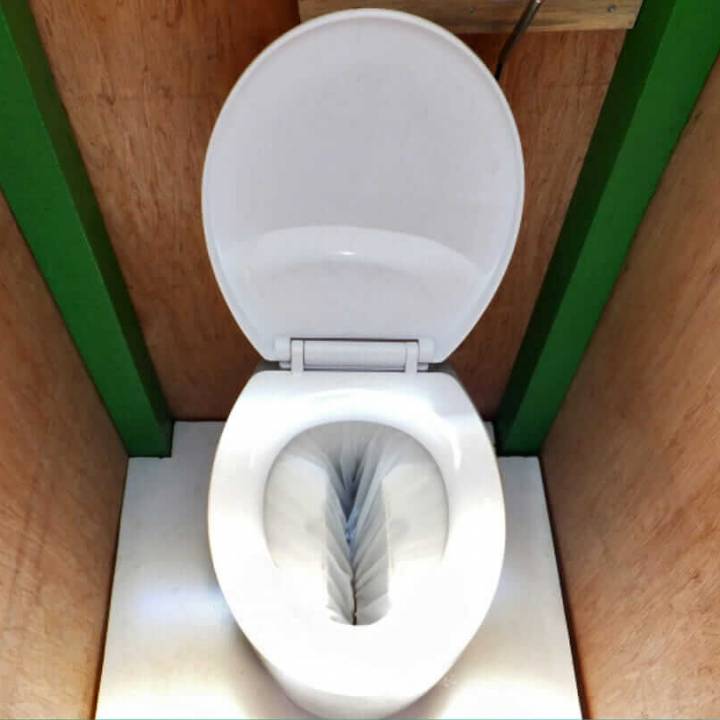
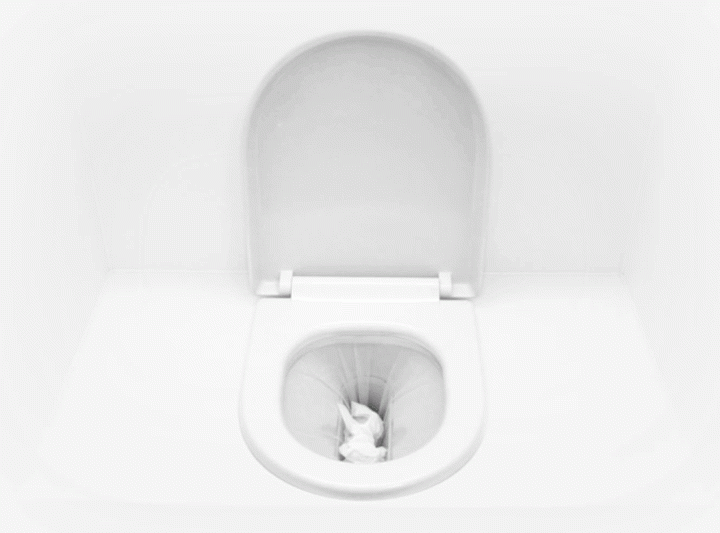
LooWatt
waterless flush toilets
Waterless flush toilets, which help to turn human excrement into fertiliser and biogas.
According to the report of WHO, about 4.2 mld of humans, which is above half of the world population, live without basic sanitation, including hygienic toilets. At least 2 mld of the world’s population drinks water which is contaminated with faeces. It favours the development of such diseases as cholera, dysentery, typhus, hepatitis A or diarrhoea, which in millions of cases still leads to death. This situation does not rather affect developed countries, but they face another problem. It is assessed that in Europe one person flushes 45 litres of water daily on average, which is about 1/3 of daily consumption. The invention of the British company Loowatt can be a solution to both problems. The company created a system of waterless and odourless toilets, in which human excrements are covered with biodegradable foil and flushed into a fermentation chamber using a foot pedal. The excrements are then handed over to the waste treatment plant, which may use them to manufacture organic fertiliser and biogas, which is, amongst others, the source of electric energy. Loowatt offers public utility and household toilets based on such a system.
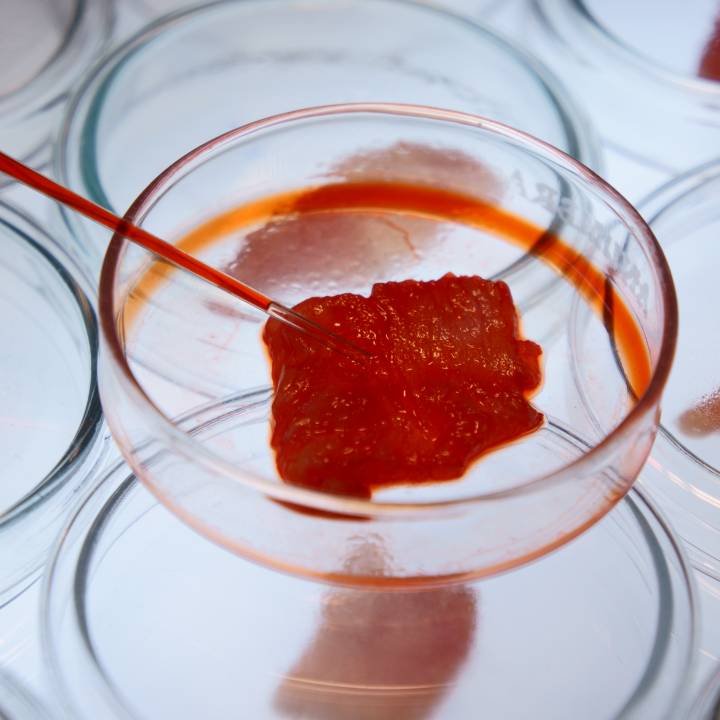
Pure meat
food
Meat manufactured outside the bodies of animals, which breeding consumes enormous quantities of water.
Industrial breeding arouses controversy due to the way animals are treated. But that is not all. The issue involves environmental impact as well (such breeding is responsible for about 19% of greenhouse gases) and water footprint. 15 thousand litres of water are required to manufacture 1 kg of beef, and 6 thousand and 4 thousand litres of water, accordingly, are required to manufacture pork and poultry. In Poland, this industry is a big problem for our water resources because we manufacture above 2.6 mln tones of meat annually. That is why, scientists who deal with the water issue look hopefully at the so-called pure meat, which is manufactured outside the animal’s bodies. How is it possible? Only cells are taken from animals, which are then placed in a special nutrition solution and stimulated to divide in order to obtain muscle fibers. The first burger was bred in such a way in 2013 by a Dutch Professor Mark Post. It cost USD 330 thousand (in Poland such meat was bred in a laboratory for the first time in 2019. The experiment was carried out by Stanisław Łoboziak). At present, there are several dozen companies which try to commercialize pure meat, and the costs were decreased by 1000 times. The technology is funded, amongst others, by Bill Gates and Richard Branson as well as by the giants of the meat industry, such as American company Tyson Foods or German company PHW.
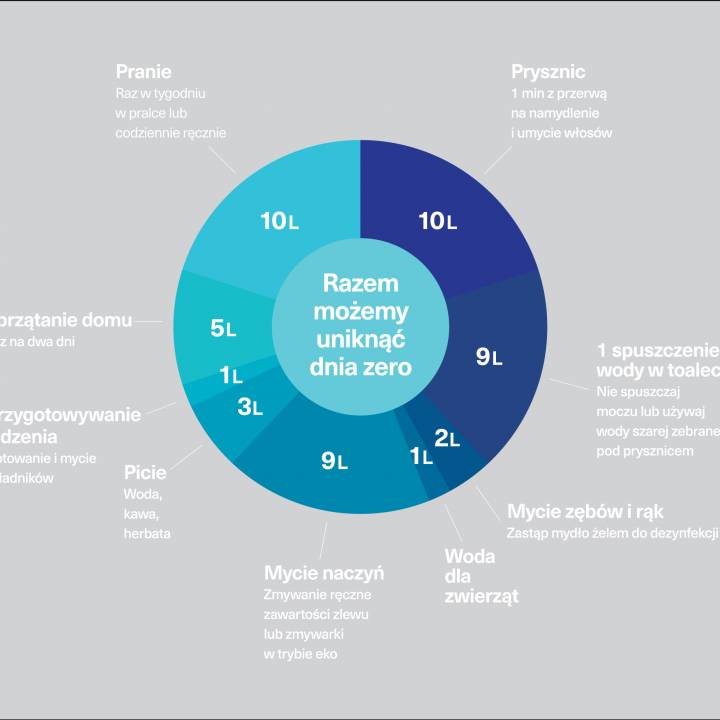
The programme aimed at limiting water consumption in Cape Town
urban project
Long-term draught in Cape Town made the authorities to introduce restrictions on citizens.
In 2017 and 2018, Cape Town faced a long-term draught, due to which local retention reservoirs were almost emptied. One of the largest cities of the Republic of South Africa was about to face the so called day zero, which is interruption of water supply to taps. To prevent it, the authorities implemented a programme of extreme savings in the companies and households. Initially, the authorities forbade lawns watering and car washing, and disinfectant gel was used instead of soap for hand washing in public places. In the following stages, citizens were allowed to consume 100, 87 and 50 litres of water per citizen daily, exceeding of which was subject to high penalties. The city also published intuitive guides which supported living in compliance with the new rules. The authorities recommended, amongst others, to use economic tap aerators, to have short 2-minute showers and to have baths with reservoirs for collection of grey water to be further used to flush the toilet. As a result, in the critical moment, water consumption in households was reduced by above 60 %, and the term day zero was systematically postponed until it started to rain, which improved the situation.
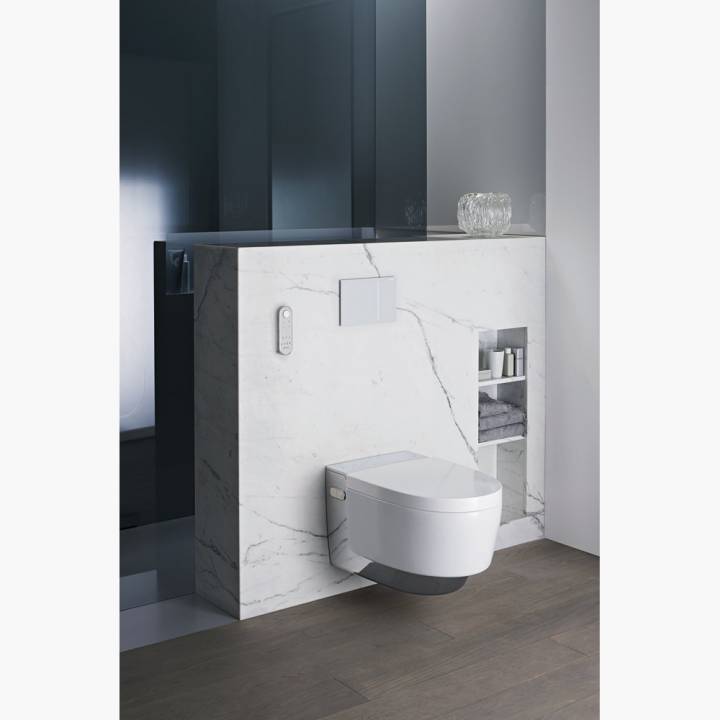
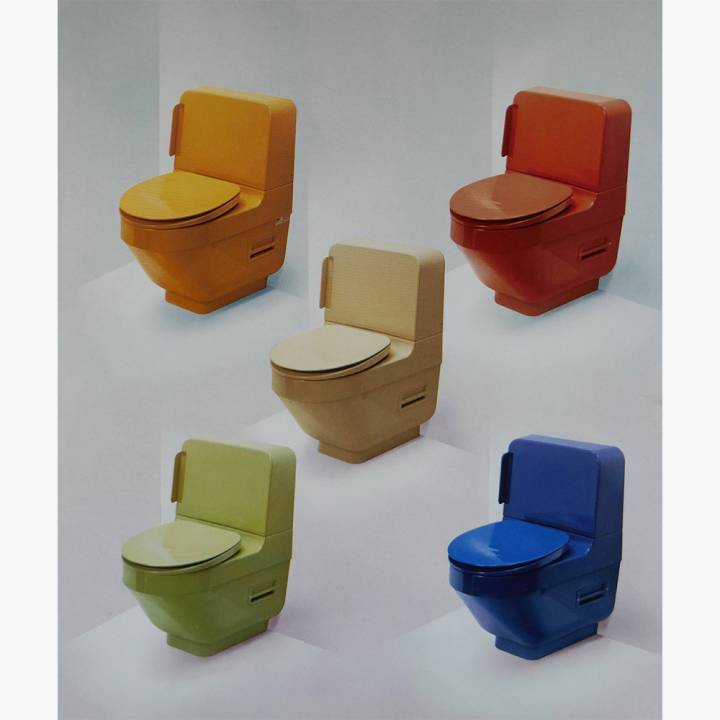
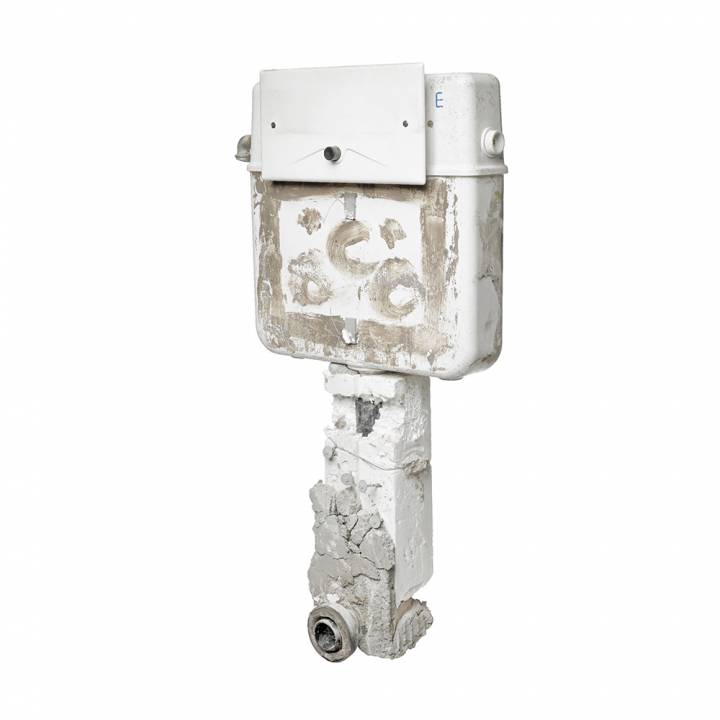
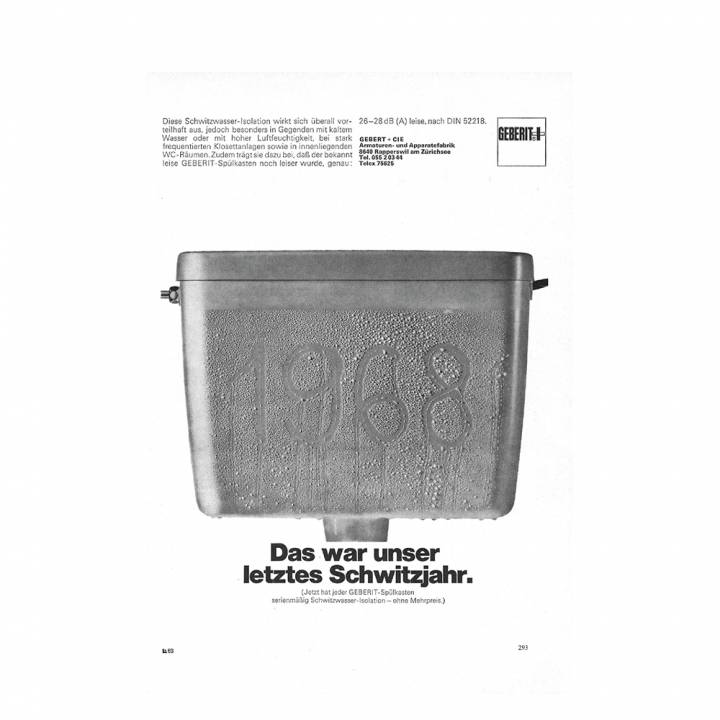
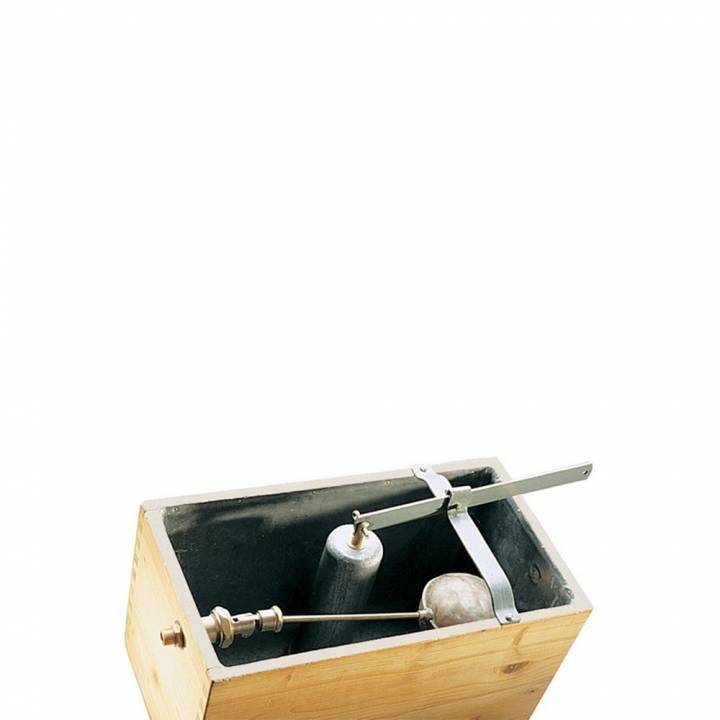
Water saving Geberit flashing set
toilet
Modern flashing sets which can limit water consumption by up to 50 L daily per person.
Toilets are often in the unwanted forefront as regards water consumption at home. All due to the old type flashing sets which are still used in many households. However, it does not have to be the case, which is proven by the history of solutions offered by the Geberit brand. Fifty years ago flashing sets could consume up to 70 l of water daily per person. However, flush-mounted versions may only need 18 litres per user, which saves over 50 litres of water daily. We owe it to more effective flashing systems, in which smaller reservoirs are used. Additionally, the pushbuttons with the STOP function are also useful or they help the user to decide if they need 6 litres or 3 litres of water to empty the toilet (there is also a possibility to reduce this amount to 4 litres and 2 litres). Geberit offers a new type of AquaClean shower toilets, which connect the function of a WC bowl with a bidet. In addition to comfort and functionality, they also offer water tightness, which is important. Novelties, such as cleaning nozzle, which guarantees air-entrained water stream, or oscillating and pulsing water stream have a large impact on the reduction of water and energy consumption.
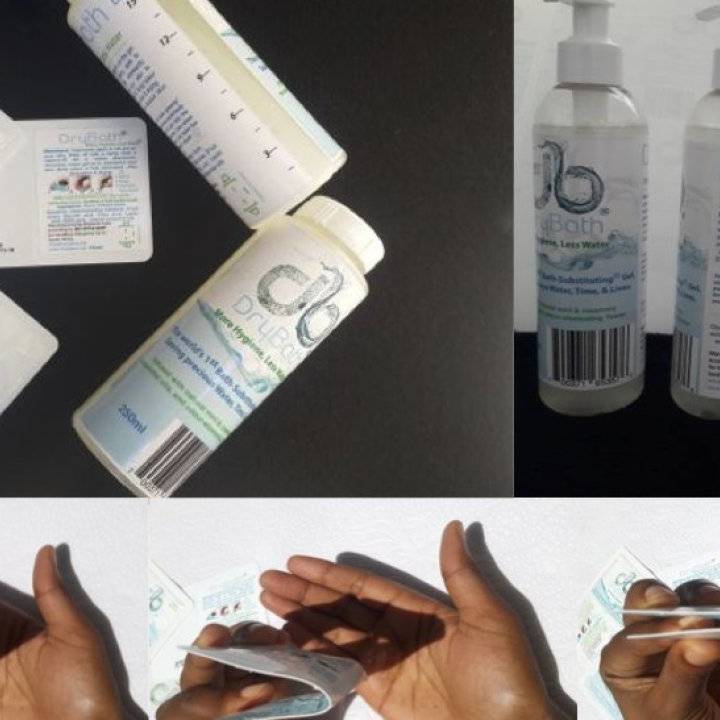
DryBath
product
First in the world bath gel which substitutes bath.
From about 150 litres of water, an average citizen of our country consumes daily, above 40% is used for washing. Due to drought in Poland, the government encourages to save water in households and to resign from having baths or long showers taking short ones instead. However, it turns out that there is a solution that will allow us to resign from them almost completely. It is DryBath gel, which was patented by Ludwick Marishane a few years ago. It is enough to use 15 ml of gel on skin so that without rinsing it you can obtain the same effect as after washing with soap or bath liquid (it removes dirt, bacteria, and unpleasant odour). In countries similar to ours, this invention can be used to lower water consumption. It is also very useful during camping or music festivals.
In South Africa, where Ludwick Marishane grew up, DryBath may save health and life. Citizens of this region often have no access to clean water, and the one they use spread dangerous diseases. One of the diseases is trachoma due to which 8 mln people annually lose their sight, even though it is enough to wash your face to protect yourself against this disease. The innovative gel turned out to be very useful in such regions during coronavirus pandemic when hygiene has become more important than ever before. “DryBath means comfort for rich and rescue for poor” – sums up Ludwick Marishane.
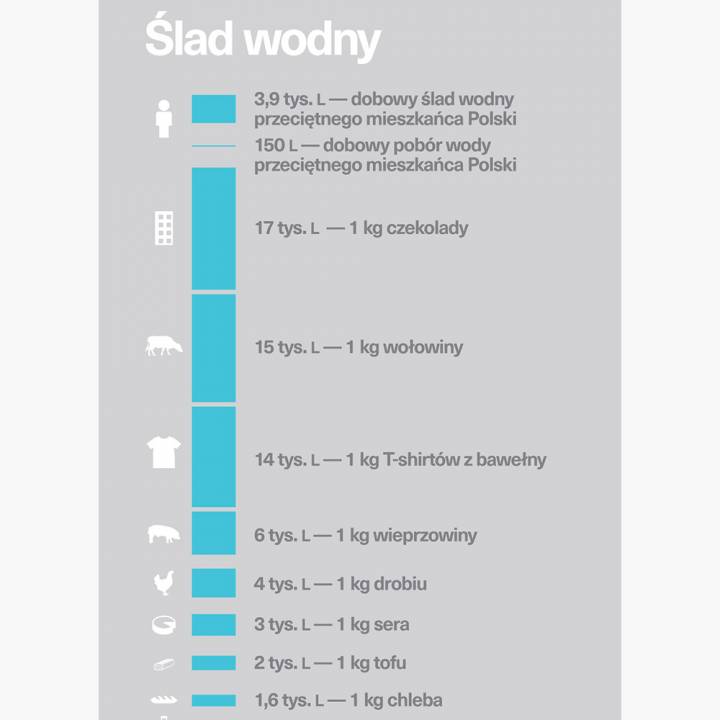
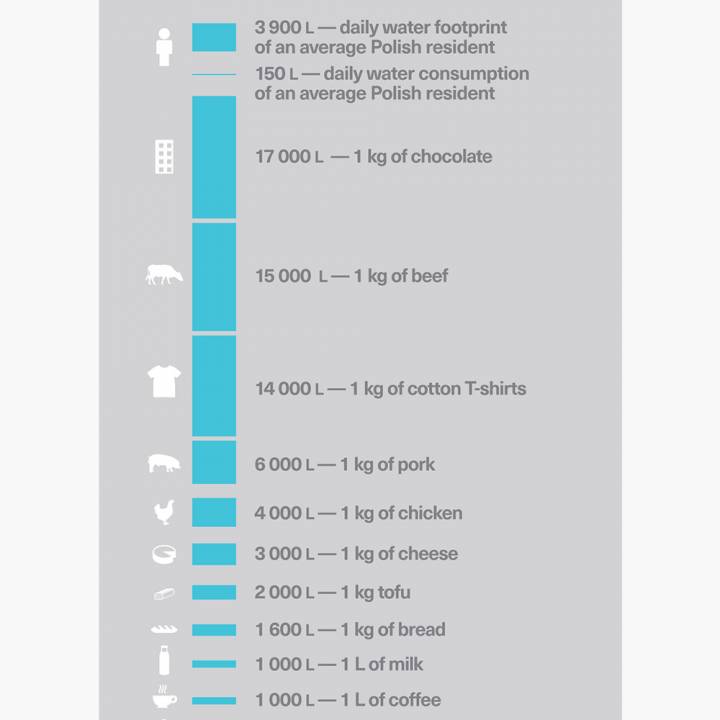
Water footprint calculator
water footprint
Online calculator which allows everyone to calculate their water footprint.
To manufacture any product, a certain quantity of water is required. That is why the term water footprint was created. It is the measurement of water consumption not directly but by the consumption of various goods, which is much higher. To compare, an average citizen of our country consumes about 150 litres of water daily, and their water footprint is 3,900 litres daily. To understand this disproportion, it is enough to look into some examples of calculations made using the Water Footprint Calculator created by The Water Footprint Network.
Chocolate is at the top of the list. To manufacture 1 kg of this sweet snack, 17 thousand litres of water are required. In the case of meat, the largest water consumption, which is 15 thousand litres, is required to manufacture 1 kg of beef. Dairy products manufacture is also connected with large water consumption. The water footprint of a glass of milk is 255 litres, and the manufacture of 1 kg cheese consumes 3 thousand litres of water. Vegan diet is much more economical in this case, but you must be careful here as well. Avocado is on the top of the list considering water consumption. To grow, it requires even as much as four times more water than tomato – above 500 litres per 1 kg. Water footprint does not only refer to food. Large quantities of water are required e.g. to manufacture clothes – 2.5 litres of water is needed to manufacture one cotton T-shirt.
Drinking
According to dieticians, each one of us should drink between 1.5 to 2.5 litres of water daily. Unfortunately, many of us fulfils this demand by buying bottled water.
An average Pole drinks about 70 litres of water annually in 50 plastic PET bottles. Annually, above 480 milliards of such packaging for various liquids is sold around the world, of which only certain part is processed. Thus, they are a significant source of our planet contamination. This is not all though. Research carried out by the Orb organization showed that microplastic was found in 93% of bottled water. Additionally, each PET bottle is characterized by a large water footprint as for the manufacture of one bottle as much as 26 litres of water is consumed. That is why, in many parts of the world drinking water straight from the tap has been promoted for some time now, and various companies, scientists, and designers attempt to find alternatives to plastic bottles.
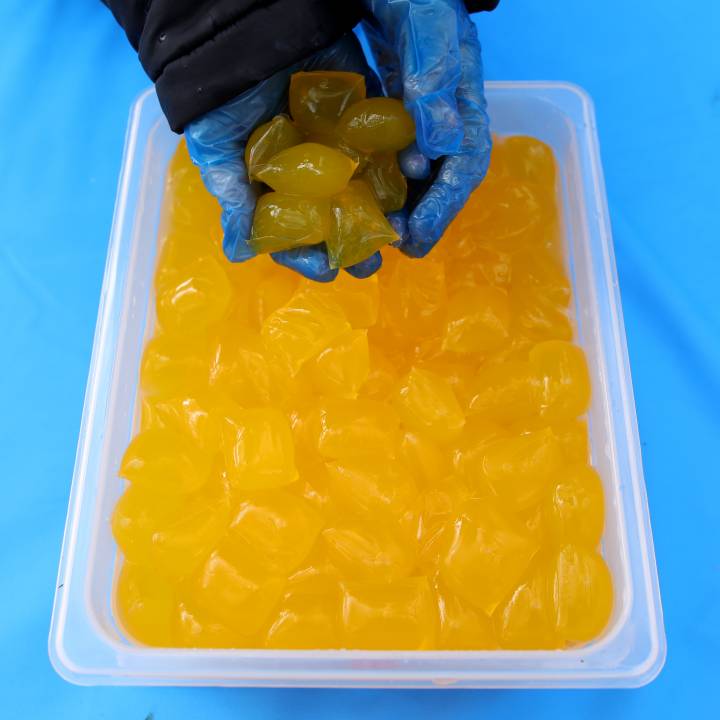
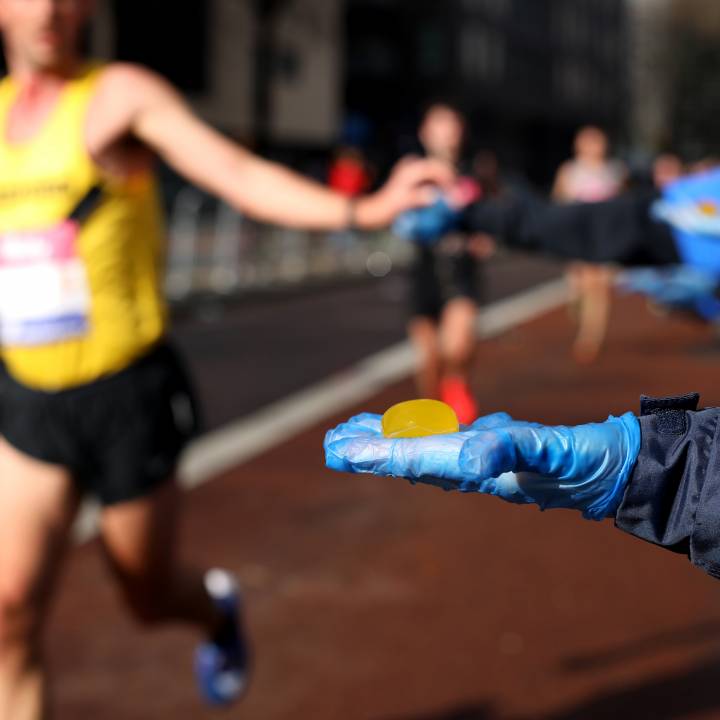
Ooho!
water in edible capsules
Water in edible capsules, which could be an alternative to plastic bottles.
The British start-up Skipping Rocks Lab wants to change the approach to the supply of potable water. Instead of bottles, public distributors, or water pipes, the company manufactures small edible capsules Ooho!, which you can put in your mouth and bite. The project was inspired by the spherification process used in molecular cuisine. To contain water, the founders used a double membrane made of calcium chloride and sodium alginate, which is a natural thickener from algae. These natural, safe for human compounds create a transparent gel wall, which is solid enough to retain the liquid inside the capsule. According to the designers, the manufacture of Ooho! is much cheaper than the manufacture of plastic bottles.
However, the technology has its limitations. The capsules undergo biodegradation within a few days, that is why for now they are mainly used at events, during mass running events, and everywhere where water can be immediately consumed.
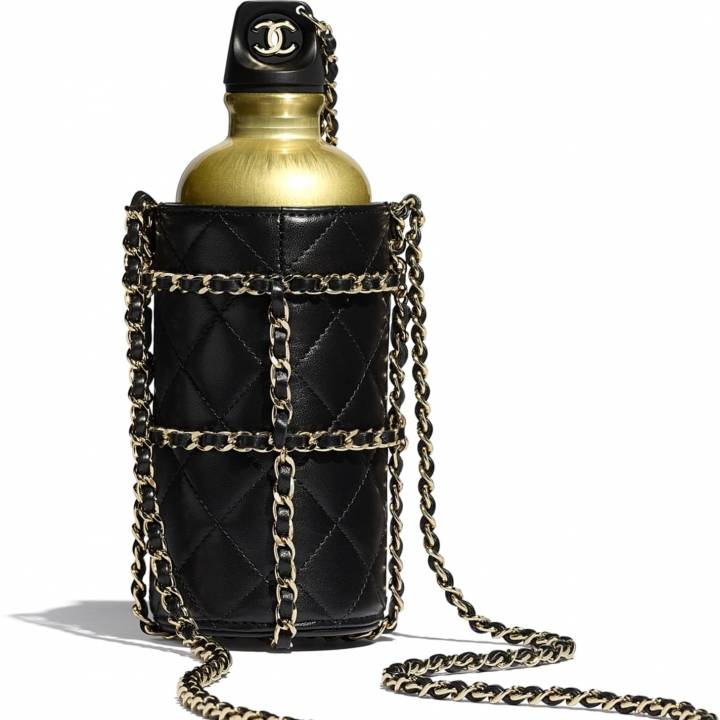
Chanel Bottle
product
Luxurious symbol of social status and ecology awareness in one, which is a reusable Chanel water bottle.
Design together with effective marketing can be very helpful in promoting good habits. It is well known to the manufacturers of reusable water bottles, which allows them, amongst others, to decrease contamination with plastic and transport-related carbon footprint. The manufacturers were able to create the product not only as a symbol of ecologic lifestyle and our aspirations, but also as a trendy accessory. There is a reason why the British Telegraph named reusable bottles the new „It-Bags” (most trendy accessory of 2018) some time ago. It is also confirmed by data and market prognosis – in May 2019, MarketWatch evaluated this industry at USD 239 mln and foreseen that up to 2025 the branch will be valued at USD 374 mln. The crowning achievement of the trend was introducing the luxurious reusable bottle to the offer of the Chanel brand as a part of its accessories collection Cruise 2020. It is offered with a lamb cover and a gold chain, thanks to which you may wear it in a cross-body variant or hold it in the hand. Even though the price is extremely high (equals to PLN 22 thousand), this bottle-like purse became the object of desire for fashion lovers from all over the world, and you had to register yourself at special lists in boutiques to get it.
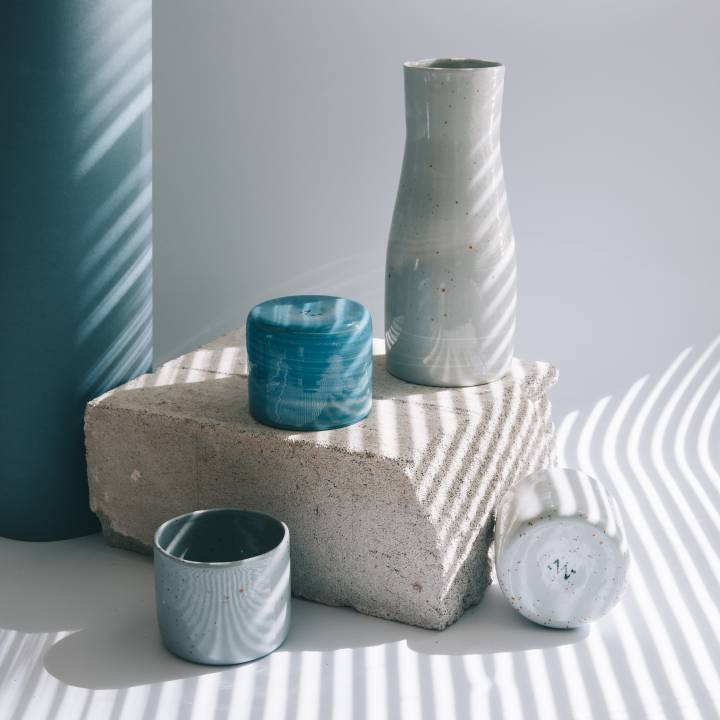
TAP
ceramic vessels set
Beautiful ceramic vessels, which will teach us to better celebrate water drinking.
The water on which our environment is based can soon become the scarce goods. Today’s society seems to forget about the live-giving role of water, exploring its sources to extremes and wasting hectolitres of water during daily activities. The project makes us reflect on respecting the environment in which we live, focusing on water and making its consumption a celebration. The TAP set is composed of a porcelain carafe, a pair of glasses (or mugs) and a water bottle made of recovered materials. All elements were designed by Spółdzielnia Socjalna Zakwas, which was founded to make its own design concepts or to support local network of handmade products. In their work, the company founders focus on ceramic, fabrics as well as recovery and processing of plastics.
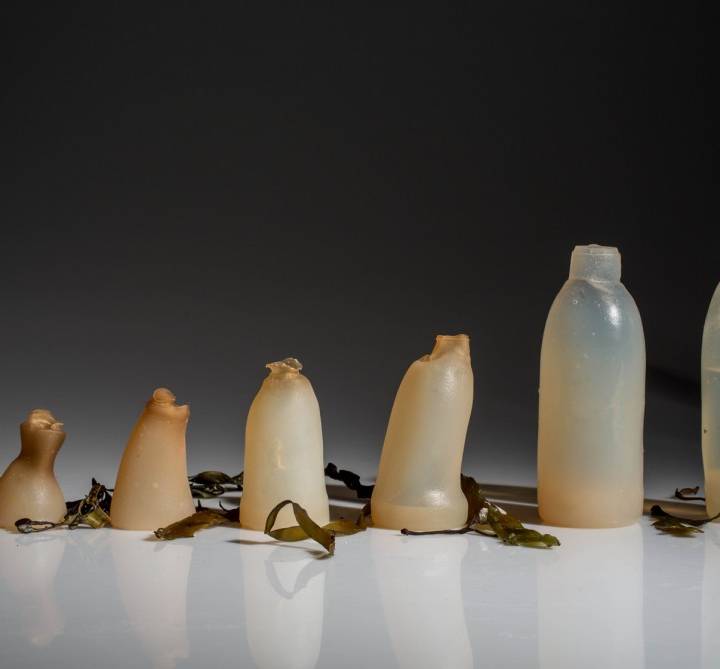
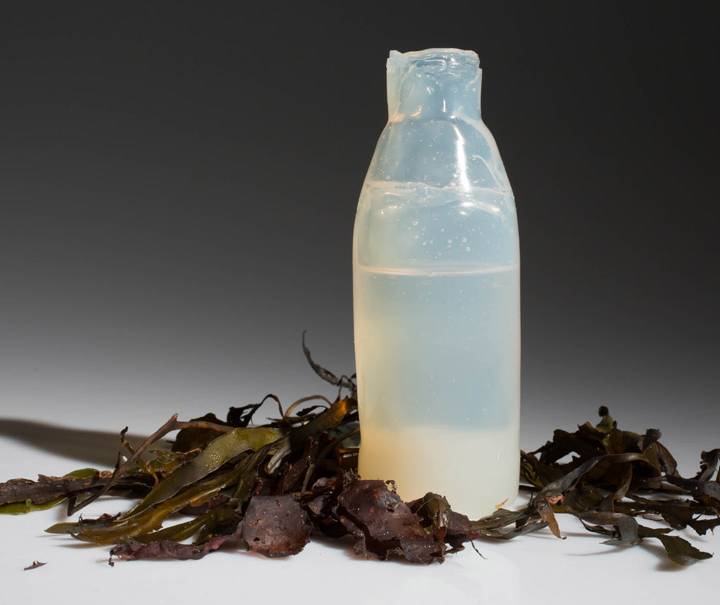
Alternative to a plastic bottle
biodegradable water bottle
Biodegradable water bottle made of red algae powder.
The search for an ecologic alternatives to plastic bottles cannot finish on making the so-called biodegradable plastics, such as PLA. Packaging made of this natural polymer, which is currently intensively promoted, undergoes decomposition only in industrial composting facilities, not in natural conditions. One of the examples of different directions is the project developed by Ari Jónsson. When during his studies he was looking for materials which can be used to develop an alternative to a plastic bottle, he found a powdered form of agar, which is manufactured of algae. After adding this product to water, a jelly-like substance is created. To make a bottle of it, the designer heats-up the mixture, pours it to the mould of appropriate shape, turns it so that the liquid fills all areas, and places it in the fridge for a few minutes. After taking the mould off the fridge and filling it with water, the bottles keep its shape. It starts to decompose only when its emptied. However, if someone likes the taste of algae, the bottle is edible as it is made in 100% natural and safe ingredients.
